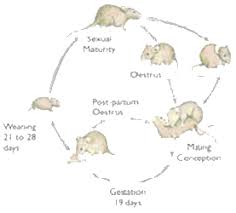PEST INFORMATION ABOUT RODENTS

Rodentia is an order of mammals also known as rodents, characterized by two continuously-growing incisors in the upper and lower jaws which must be kept short by gnawing. Forty percent of mammal species are rodents, and they are found in vast numbers on all continents other than Antarctica. Common rodents include mice, rats, squirrels, chipmunks, gophers, porcupines, beavers, hamsters, gerbils, guinea pigs, degus, chinchillas, prairie dogs, and groundhogs.Rodents have sharp incisors that they use to gnaw wood, break into food, and bite predators. Most eat seeds or plants, though some have more varied diets. Some species have historically been pests, eating human seed stores and spreading disease.
Rats are various medium sized, long-tailed rodents of the superfamily Muroidea. “True rats” are members of the genus Rattus, the most important of which to humans are the black rat, Rattus Rattus, and the brown rat (or Norway rat), Rattus norvegicus. Many members of other rodent genera and families are also called rats and share many characteristics with true rats.
Three major pest species of rodents



——Roof or Black Rat —————————————–Norway or Brown Rat——————————————-Common House Mouse
The identification of each species is essential to formulate an effective control program. Rats and mice can eat through cables, ruin insulation and transmit disease to humans by contaminating food.
Various treatments are available to deal with this pest including options to protect children and pets
PEST CONTROL FOR RATS AND MICE
Professional knowledge of the rodents habits is essential to eradicate a problem. Be careful with using poisons to rid your house of rodents. It will kill them, but you may not be able to find the dead animal and it may cause a stink! Depending on the severity of your problem, you have several options. If your house is completely infested, seek the help of a professional.
Pest control options may include the use of sticky
straps, mechanical traps and the selective use of latest generation rat
baits. Any rat baiting program should use safety dispensers placed in
areas and is secure from access by children and pets – such as in a roof
void and sealed sub-floor and/or storage rooms.
- Try peppermint oil. Peppermint oil is a natural deterrent. The smell is simply too intense for rodents and they will not try to go near it. It also helps to mask the scent of any tasty morsels that have been missed when cleaning. You can get peppermint oil in most health food stores and even some major grocery stores. Place a drop or two on a cotton ball. Place the cotton balls in areas where mice are likely to enter your house, by doorways or heat vents, etc. Another helpful deterrent is to grow peppermint plants near the entryways. You can use the mint in cooking as well as it serving a deterrent purpose.
- Seal the possible entries. Mice can get through tiny holes (if the head can get through, the body can), but the best way of having a mice free house is to close any possible entry. While this can be hard to achieve in old houses, it is the most effective solution. A good way to board up small holes is by using green kitchen pads (those used for cleaning pans and such) cut to the right size.
- Stick steel wool in mouse holes. Steel wool pads will prevent mice from using the hole to get back into your house. Better still, it’s too tough for mice to chew through.
- Place tubs of used kitty litter around entrances the house. The mice will sniff the smell of cat urine and clear off in a jiffy.
- Bait some mouse traps if you’re not squeamish or opposed to this method. Good old fashioned mouse traps baited with peanut butter or bacon grease tend to work. They are more humane than glue traps but occasionally fail to kill, and may just maim. Glue traps catch the mouse, but it will not kill them. You will have to do the deed yourself. Electric mouse traps are highly effective. These will electrocute a mouse within 10 seconds of contact.
- Try a humane trap. There are traps that catch the mouse in a box. The mouse can get in but not out. This can be a humane way to catch mice, but it can be a hassle because you must go to a remote location to release them. You don’t want to throw them in the back yard because they will just come back in!
- Zap with beeps. There is an electronic unit that emits a beeping sound that rodents hate. This sound is not a hazard to dogs and cats and can be bought at hardware stores .
- Keep your home clean. If there is nothing to eat, they will be less likely to stay.



